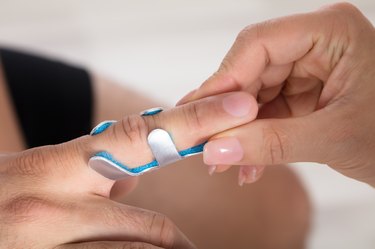
A finger fracture can make it quite hard to go about your daily routine. Your doctor will probably recommend physical therapy for your broken finger to help with the healing process; broken finger recovery exercises can help combat pain and stiffness, and improve your finger's flexibility.
Read more: Ways to Exercise With a Broken Finger
Video of the Day
Video of the Day
Physical Therapy for a Broken Finger
The American Academy of Orthopaedic Surgeons notes that the human hand has 27 bones, of which 14 are in the fingers (phalanges). Your thumb has two bones and each of your other fingers has three. The bones in your hand line up precisely, enabling you to do a number of specialized tasks like grasping a pencil or gripping a handle. Fracturing a bone in your finger can put your whole hand out of alignment, so it's important to get it treated.
Luckily, most finger fractures don't require surgery, says a January 2016 study published in the journal Duodecim. The American Academy of Orthopaedic Surgeons explains that your doctor might put your finger in a splint or cast, after setting the bone, to hold it in place and prevent further injury. When it's safe to move your finger again, doing certain exercises every day can help reduce swelling and stiffness.
Moving your fingers is also important if you've had surgery to repair the fracture; a May 2015 study published in the journal BMC Proceedings notes that moving your fingers after surgery can help ensure that your tendons and joints do not get stuck.
Finger fractures usually take four to six weeks to heal; however, some cases may take longer. Following your doctor's instructions and going regularly for your check-ups can help ensure that your finger is healing as it should.
Read more: Finger Dexterity Exercises
Finger Exercises to Do After a Fracture
The American Academy of Family Physicians lists certain exercises you can do every day to help reduce your pain, strengthen your finger and improve flexibility, so that you can eventually move your finger normally again. Before you attempt any of the exercises, you should check with your doctor to ensure that they are safe for you to do. Try to do each exercise eight to 12 times. If any exercise causes you pain beyond mild discomfort, stop doing it.
Move 1: Range of Motion
- Grasp your injured finger with your uninjured hand and use it to slowly straighten your injured finger.
- Hold your injured finger in the straightened position.
- Use your uninjured hard to slowly bend your injured finger.
Move 2: Finger Extension
- Place your injured hand on a table, with your palm facing downward.
- Slowly lift one finger at a time and then return it to the table.
Move 3: Grip Strengthening
- Make a fist with your injured hand.
- Hold it for several seconds.
Tip
You can start by doing this exercise with just your hand. After some time you can start doing it with a soft ball, like a tennis ball or a stress ball. If you opt for the former, making a cut in the side of the ball can make it easier to squeeze.
Move 4: Object Pick-Up
- Locate small objects like buttons, coins or marbles.
- Use your injured finger and your thumb to pick them up.
Read more: How to Stop Foot Pain With 7 Easy Exercises
- American Academy of Orthopaedic Surgeons: “Finger Fractures”
- Duodecim: “Conservative Treatment of Finger Fractures”
- BMC Proceedings: “Better Results of Finger Fractures With Wide Awake Surgery and Early Protected Motion”
- Fairview: “Finger Fracture, Closed”
- American Academy of Family Physicians: “Exercising Your Finger After an Injury”
- Kaiser Permanente: “Finger Fracture: Rehab Exercises”
Is this an emergency? If you are experiencing serious medical symptoms, please see the National Library of Medicine’s list of signs you need emergency medical attention or call 911.